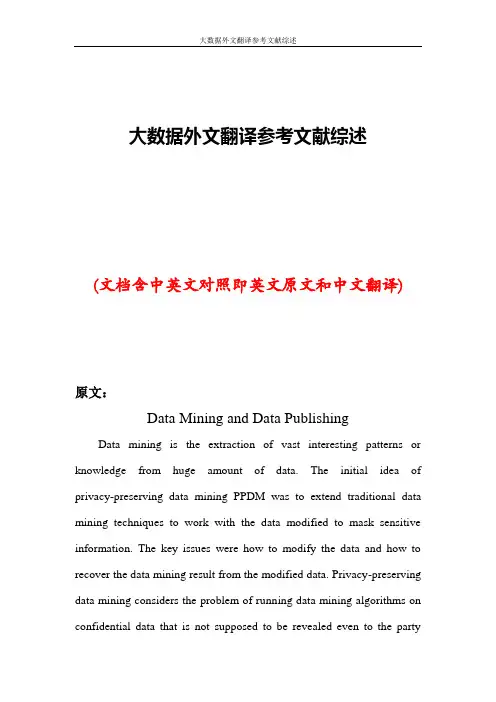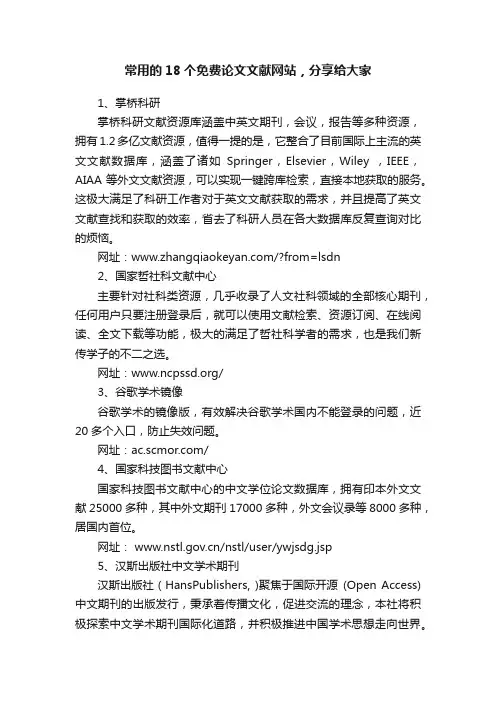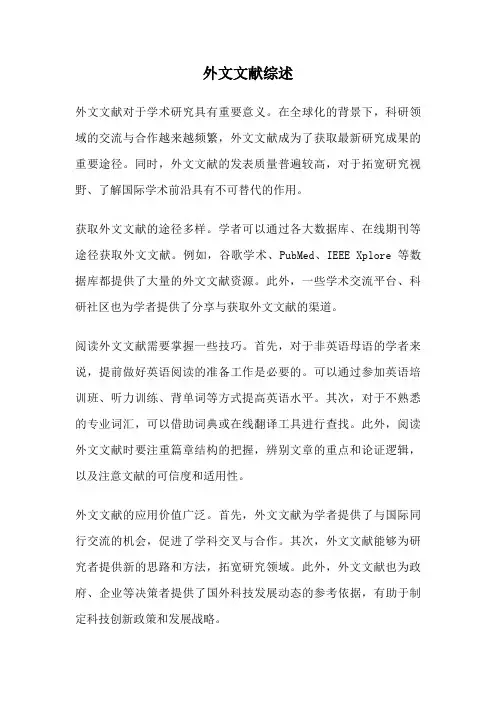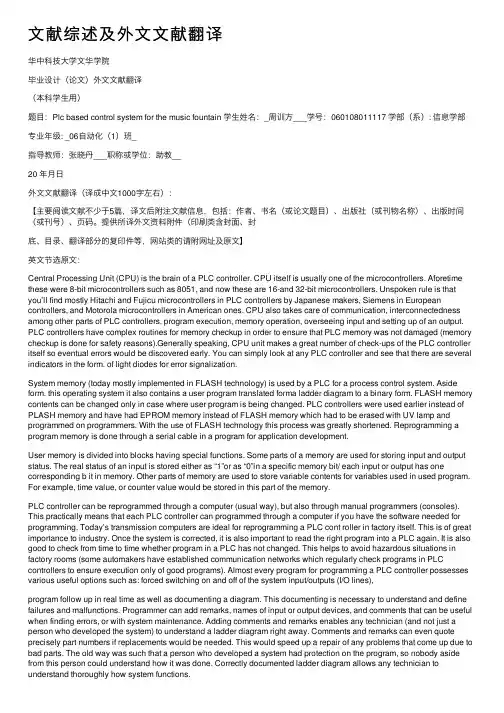文献综述,外文翻译,论文网站
大数据外文翻译参考文献综述

大数据外文翻译参考文献综述(文档含中英文对照即英文原文和中文翻译)原文:Data Mining and Data PublishingData mining is the extraction of vast interesting patterns or knowledge from huge amount of data. The initial idea of privacy-preserving data mining PPDM was to extend traditional data mining techniques to work with the data modified to mask sensitive information. The key issues were how to modify the data and how to recover the data mining result from the modified data. Privacy-preserving data mining considers the problem of running data mining algorithms on confidential data that is not supposed to be revealed even to the partyrunning the algorithm. In contrast, privacy-preserving data publishing (PPDP) may not necessarily be tied to a specific data mining task, and the data mining task may be unknown at the time of data publishing. PPDP studies how to transform raw data into a version that is immunized against privacy attacks but that still supports effective data mining tasks. Privacy-preserving for both data mining (PPDM) and data publishing (PPDP) has become increasingly popular because it allows sharing of privacy sensitive data for analysis purposes. One well studied approach is the k-anonymity model [1] which in turn led to other models such as confidence bounding, l-diversity, t-closeness, (α,k)-anonymity, etc. In particular, all known mechanisms try to minimize information loss and such an attempt provides a loophole for attacks. The aim of this paper is to present a survey for most of the common attacks techniques for anonymization-based PPDM & PPDP and explain their effects on Data Privacy.Although data mining is potentially useful, many data holders are reluctant to provide their data for data mining for the fear of violating individual privacy. In recent years, study has been made to ensure that the sensitive information of individuals cannot be identified easily.Anonymity Models, k-anonymization techniques have been the focus of intense research in the last few years. In order to ensure anonymization of data while at the same time minimizing the informationloss resulting from data modifications, everal extending models are proposed, which are discussed as follows.1.k-Anonymityk-anonymity is one of the most classic models, which technique that prevents joining attacks by generalizing and/or suppressing portions of the released microdata so that no individual can be uniquely distinguished from a group of size k. In the k-anonymous tables, a data set is k-anonymous (k ≥ 1) if each record in the data set is in- distinguishable from at least (k . 1) other records within the same data set. The larger the value of k, the better the privacy is protected. k-anonymity can ensure that individuals cannot be uniquely identified by linking attacks.2. Extending ModelsSince k-anonymity does not provide sufficient protection against attribute disclosure. The notion of l-diversity attempts to solve this problem by requiring that each equivalence class has at least l well-represented value for each sensitive attribute. The technology of l-diversity has some advantages than k-anonymity. Because k-anonymity dataset permits strong attacks due to lack of diversity in the sensitive attributes. In this model, an equivalence class is said to have l-diversity if there are at least l well-represented value for the sensitive attribute. Because there are semantic relationships among the attribute values, and different values have very different levels of sensitivity. Afteranonymization, in any equivalence class, the frequency (in fraction) of a sensitive value is no more than α.3. Related Research AreasSeveral polls show that the public has an in- creased sense of privacy loss. Since data mining is often a key component of information systems, homeland security systems, and monitoring and surveillance systems, it gives a wrong impression that data mining is a technique for privacy intrusion. This lack of trust has become an obstacle to the benefit of the technology. For example, the potentially beneficial data mining re- search project, Terrorism Information Awareness (TIA), was terminated by the US Congress due to its controversial procedures of collecting, sharing, and analyzing the trails left by individuals. Motivated by the privacy concerns on data mining tools, a research area called privacy-reserving data mining (PPDM) emerged in 2000. The initial idea of PPDM was to extend traditional data mining techniques to work with the data modified to mask sensitive information. The key issues were how to modify the data and how to recover the data mining result from the modified data. The solutions were often tightly coupled with the data mining algorithms under consideration. In contrast, privacy-preserving data publishing (PPDP) may not necessarily tie to a specific data mining task, and the data mining task is sometimes unknown at the time of data publishing. Furthermore, some PPDP solutions emphasize preserving the datatruthfulness at the record level, but PPDM solutions often do not preserve such property. PPDP Differs from PPDM in Several Major Ways as Follows :1) PPDP focuses on techniques for publishing data, not techniques for data mining. In fact, it is expected that standard data mining techniques are applied on the published data. In contrast, the data holder in PPDM needs to randomize the data in such a way that data mining results can be recovered from the randomized data. To do so, the data holder must understand the data mining tasks and algorithms involved. This level of involvement is not expected of the data holder in PPDP who usually is not an expert in data mining.2) Both randomization and encryption do not preserve the truthfulness of values at the record level; therefore, the released data are basically meaningless to the recipients. In such a case, the data holder in PPDM may consider releasing the data mining results rather than the scrambled data.3) PPDP primarily “anonymizes” the data by hiding the identity of record owners, whereas PPDM seeks to directly hide the sensitive data. Excellent surveys and books in randomization and cryptographic techniques for PPDM can be found in the existing literature. A family of research work called privacy-preserving distributed data mining (PPDDM) aims at performing some data mining task on a set of private databasesowned by different parties. It follows the principle of Secure Multiparty Computation (SMC), and prohibits any data sharing other than the final data mining result. Clifton et al. present a suite of SMC operations, like secure sum, secure set union, secure size of set intersection, and scalar product, that are useful for many data mining tasks. In contrast, PPDP does not perform the actual data mining task, but concerns with how to publish the data so that the anonymous data are useful for data mining. We can say that PPDP protects privacy at the data level while PPDDM protects privacy at the process level. They address different privacy models and data mining scenarios. In the field of statistical disclosure control (SDC), the research works focus on privacy-preserving publishing methods for statistical tables. SDC focuses on three types of disclosures, namely identity disclosure, attribute disclosure, and inferential disclosure. Identity disclosure occurs if an adversary can identify a respondent from the published data. Revealing that an individual is a respondent of a data collection may or may not violate confidentiality requirements. Attribute disclosure occurs when confidential information about a respondent is revealed and can be attributed to the respondent. Attribute disclosure is the primary concern of most statistical agencies in deciding whether to publish tabular data. Inferential disclosure occurs when individual information can be inferred with high confidence from statistical information of the published data.Some other works of SDC focus on the study of the non-interactive query model, in which the data recipients can submit one query to the system. This type of non-interactive query model may not fully address the information needs of data recipients because, in some cases, it is very difficult for a data recipient to accurately construct a query for a data mining task in one shot. Consequently, there are a series of studies on the interactive query model, in which the data recipients, including adversaries, can submit a sequence of queries based on previously received query results. The database server is responsible to keep track of all queries of each user and determine whether or not the currently received query has violated the privacy requirement with respect to all previous queries. One limitation of any interactive privacy-preserving query system is that it can only answer a sublinear number of queries in total; otherwise, an adversary (or a group of corrupted data recipients) will be able to reconstruct all but 1 . o(1) fraction of the original data, which is a very strong violation of privacy. When the maximum number of queries is reached, the query service must be closed to avoid privacy leak. In the case of the non-interactive query model, the adversary can issue only one query and, therefore, the non-interactive query model cannot achieve the same degree of privacy defined by Introduction the interactive model. One may consider that privacy-reserving data publishing is a special case of the non-interactivequery model.This paper presents a survey for most of the common attacks techniques for anonymization-based PPDM & PPDP and explains their effects on Data Privacy. k-anonymity is used for security of respondents identity and decreases linking attack in the case of homogeneity attack a simple k-anonymity model fails and we need a concept which prevent from this attack solution is l-diversity. All tuples are arranged in well represented form and adversary will divert to l places or on l sensitive attributes. l-diversity limits in case of background knowledge attack because no one predicts knowledge level of an adversary. It is observe that using generalization and suppression we also apply these techniques on those attributes which doesn’t need th is extent of privacy and this leads to reduce the precision of publishing table. e-NSTAM (extended Sensitive Tuples Anonymity Method) is applied on sensitive tuples only and reduces information loss, this method also fails in the case of multiple sensitive tuples.Generalization with suppression is also the causes of data lose because suppression emphasize on not releasing values which are not suited for k factor. Future works in this front can include defining a new privacy measure along with l-diversity for multiple sensitive attribute and we will focus to generalize attributes without suppression using other techniques which are used to achieve k-anonymity because suppression leads to reduce the precision ofpublishing table.译文:数据挖掘和数据发布数据挖掘中提取出大量有趣的模式从大量的数据或知识。
常用的18个免费论文文献网站,分享给大家

常用的18个免费论文文献网站,分享给大家1、掌桥科研掌桥科研文献资源库涵盖中英文期刊,会议,报告等多种资源,拥有1.2多亿文献资源,值得一提的是,它整合了目前国际上主流的英文文献数据库,涵盖了诸如Springer,Elsevier,Wiley ,IEEE,AIAA等外文文献资源,可以实现一键跨库检索,直接本地获取的服务。
这极大满足了科研工作者对于英文文献获取的需求,并且提高了英文文献查找和获取的效率,省去了科研人员在各大数据库反复查询对比的烦恼。
网址:/?from=lsdn2、国家哲社科文献中心主要针对社科类资源,几乎收录了人文社科领域的全部核心期刊,任何用户只要注册登录后,就可以使用文献检索、资源订阅、在线阅读、全文下载等功能,极大的满足了哲社科学者的需求,也是我们新传学子的不二之选。
网址:/3、谷歌学术镜像谷歌学术的镜像版,有效解决谷歌学术国内不能登录的问题,近20多个入口,防止失效问题。
网址:/4、国家科技图书文献中心国家科技图书文献中心的中文学位论文数据库,拥有印本外文文献25000多种,其中外文期刊17000多种,外文会议录等8000多种,居国内首位。
网址: /nstl/user/ywjsdg.jsp5、汉斯出版社中文学术期刊汉斯出版社(HansPublishers, )聚焦于国际开源(Open Access) 中文期刊的出版发行,秉承着传播文化,促进交流的理念,本社将积极探索中文学术期刊国际化道路,并积极推进中国学术思想走向世界。
网址:/journal/ASS.html6、Open Access LibraryOALib 是一个开放存取资源图书馆,意味着可以免费下载学术论文。
所有的文章都来自顶级的出版商和数据库,可以满足各个领域学者的需求。
网址:/7、剑桥大学机构知识库剑桥大学机构知识库是由Cambridge University Library和University Computing Service维护,提供剑桥大学相关的期刊、学术论文、学位论文等电子资源。
写文献综述好用的工具

文献检索工具:
1️⃣ PubMed是NIH的免费工具,支持检索生物医学和生命科学文献。
2️⃣ Google Scholar是一个免费工具,可让您搜索最新的学术文章、文档和书籍。
3️⃣ Elicit是一个免费的Al应用程序,可帮助您查找论文、提取数据、总结、头脑风暴想法等。
文献梳理工具:
1️⃣ Research Rabbit是一个免费的文献综述工具,支持可视化文献中的复杂关系。
2️⃣ Connected Papers是一个可视化工具,可帮助研究人员找到和探索与其工作领域相关的论文和趋势。
3️⃣ LitMaps帮助您找到用于文献检索的文章和论文。
它生成与您的核心论文相关的最相关文章的地图。
文献润色工具:
1️⃣ Grammarly是一个写作助手,用于检查拼写、语法、标点错误和词汇使用。
2️⃣ Paperpal通过深入的语言和语法校正的实时建议,帮助学者写得更好、更快。
3️⃣ QuillBot的Al-powered释义工具有助于重写、编辑和更改文本的语气,以提高清晰度。
文献管理工具:
1️⃣ Zotero是一个功能强大、易于使用的研究工具,可帮助您组织、分析和引用学术文献来源。
2️⃣ Mendeley是一个引文管理工具,可让您收集和组织引文,然后轻松将其插入到文档中。
3️⃣ EndNote是一个个人引用/参考书目管理器工具,可帮助研究人员在MS Word中创建参考书目和格式参考。
外文文献综述

外文文献综述
外文文献对于学术研究具有重要意义。
在全球化的背景下,科研领域的交流与合作越来越频繁,外文文献成为了获取最新研究成果的重要途径。
同时,外文文献的发表质量普遍较高,对于拓宽研究视野、了解国际学术前沿具有不可替代的作用。
获取外文文献的途径多样。
学者可以通过各大数据库、在线期刊等途径获取外文文献。
例如,谷歌学术、PubMed、IEEE Xplore等数据库都提供了大量的外文文献资源。
此外,一些学术交流平台、科研社区也为学者提供了分享与获取外文文献的渠道。
阅读外文文献需要掌握一些技巧。
首先,对于非英语母语的学者来说,提前做好英语阅读的准备工作是必要的。
可以通过参加英语培训班、听力训练、背单词等方式提高英语水平。
其次,对于不熟悉的专业词汇,可以借助词典或在线翻译工具进行查找。
此外,阅读外文文献时要注重篇章结构的把握,辨别文章的重点和论证逻辑,以及注意文献的可信度和适用性。
外文文献的应用价值广泛。
首先,外文文献为学者提供了与国际同行交流的机会,促进了学科交叉与合作。
其次,外文文献能够为研究者提供新的思路和方法,拓宽研究领域。
此外,外文文献也为政府、企业等决策者提供了国外科技发展动态的参考依据,有助于制定科技创新政策和发展战略。
外文文献对于学术研究具有重要意义,了解外文文献的获取途径和阅读技巧对于扩大研究视野、提高学术水平至关重要。
外文文献的应用价值也不容忽视,对于促进学科交流与合作、拓宽研究领域、指导科技发展具有积极作用。
因此,学者们应该重视外文文献的阅读和应用,并不断提升自己的外文文献获取与阅读能力。
文献综述及外文文献翻译

⽂献综述及外⽂⽂献翻译华中科技⼤学⽂华学院毕业设计(论⽂)外⽂⽂献翻译(本科学⽣⽤)题⽬:Plc based control system for the music fountain 学⽣姓名:_周训⽅___学号:060108011117 学部(系): 信息学部专业年级: _06⾃动化(1)班_指导教师:张晓丹___职称或学位:助教__20 年⽉⽇外⽂⽂献翻译(译成中⽂1000字左右):【主要阅读⽂献不少于5篇,译⽂后附注⽂献信息,包括:作者、书名(或论⽂题⽬)、出版社(或刊物名称)、出版时间(或刊号)、页码。
提供所译外⽂资料附件(印刷类含封⾯、封底、⽬录、翻译部分的复印件等,⽹站类的请附⽹址及原⽂】英⽂节选原⽂:Central Processing Unit (CPU) is the brain of a PLC controller. CPU itself is usually one of the microcontrollers. Aforetime these were 8-bit microcontrollers such as 8051, and now these are 16-and 32-bit microcontrollers. Unspoken rule is that you’ll find mostly Hitachi and Fujicu microcontrollers in PLC controllers by Japanese makers, Siemens in European controllers, and Motorola microcontrollers in American ones. CPU also takes care of communication, interconnectedness among other parts of PLC controllers, program execution, memory operation, overseeing input and setting up of an output. PLC controllers have complex routines for memory checkup in order to ensure that PLC memory was not damaged (memory checkup is done for safety reasons).Generally speaking, CPU unit makes a great number of check-ups of the PLC controller itself so eventual errors would be discovered early. You can simply look at any PLC controller and see that there are several indicators in the form. of light diodes for error signalization.System memory (today mostly implemented in FLASH technology) is used by a PLC for a process control system. Aside form. this operating system it also contains a user program translated forma ladder diagram to a binary form. FLASH memory contents can be changed only in case where user program is being changed. PLC controllers were used earlier instead of PLASH memory and have had EPROM memory instead of FLASH memory which had to be erased with UV lamp and programmed on programmers. With the use of FLASH technology this process was greatly shortened. Reprogramming a program memory is done through a serial cable in a program for application development.User memory is divided into blocks having special functions. Some parts of a memory are used for storing input and output status. The real status of an input is stored either as “1”or as “0”in a specific memory bit/ each input or output has one corresponding b it in memory. Other parts of memory are used to store variable contents for variables used in used program. For example, time value, or counter value would be stored in this part of the memory.PLC controller can be reprogrammed through a computer (usual way), but also through manual programmers (consoles). This practically means that each PLC controller can programmed through a computer if you have the software needed for programming. Today’s transmission computers are ideal for reprogramming a PLC cont roller in factory itself. This is of great importance to industry. Once the system is corrected, it is also important to read the right program into a PLC again. It is also good to check from time to time whether program in a PLC has not changed. This helps to avoid hazardous situations in factory rooms (some automakers have established communication networks which regularly check programs in PLC controllers to ensure execution only of good programs). Almost every program for programming a PLC controller possesses various useful options such as: forced switching on and off of the system input/outputs (I/O lines),program follow up in real time as well as documenting a diagram. This documenting is necessary to understand and define failures and malfunctions. Programmer can add remarks, names of input or output devices, and comments that can be useful when finding errors, or with system maintenance. Adding comments and remarks enables any technician (and not just a person who developed the system) to understand a ladder diagram right away. Comments and remarks can even quote precisely part numbers if replacements would be needed. This would speed up a repair of any problems that come up due to bad parts. The old way was such that a person who developed a system had protection on the program, so nobody aside from this person could understand how it was done. Correctly documented ladder diagram allows any technician to understand thoroughly how system functions.Electrical supply is used in bringing electrical energy to central processing unit. Most PLC controllers work either at 24 VDC or 220 VAC. On some PLC controllers you’ll find electrical supply as a separate module. Those are usually bigger PLC controllers, while small and medium series already contain the supply module. User has to determine how much current to take from I/O module to ensure that electrical supply provides appropriate amount of current. Different types of modules use different amounts of electrical current. This electrical supply is usually not used to start external input or output. User has to provide separate supplies in starting PLC controller inputs because then you can ensure so called “pure” supply for the PLC controller. With pure supply we mean supply where industrial environment can not affect it damagingly. Some of the smaller PLC controllers supply their inputs with voltage from a small supply source already incorporated into a PLC.中⽂翻译:从结构上分,PLC分为固定式和组合式(模块式)两种。
免费的7个中英文文献资料检索网站,值得您收藏

免费的7个中英文文献资料检索网站,值得您收藏写作学术论文离不开文献资料的查找使用。
那么除了在知网、万方、维普等国内数据库以及百度文库等进行文献检索外,还有没有其他的比较好的文献引擎呢?特别是搜索外文文献的网站?答案是肯定的。
今天易起论文的小编就为大家推荐7个「学术文献检索工具」。
1.Citeseerx「Citeseerx」官网首页/CiteSeerX是CiteSeer的换代产品。
CiteSeerX与CiteSeer 一样,也公开在网上提供完全免费的服务,实现全天24h实时更新。
CiteSeer引文搜索引擎由美国普林斯顿大学NEC 研究院研制开发。
CiteSeer引文搜索引擎是利用自动引文标引系统(ACI)建立的第一个学术论文数字图书馆。
CiteSeerX采用机器自动识别技术搜集网上以Postscrip和PDF文件格式存在的学术论文,然后依照引文索引方法标引和链接每一篇文章。
CiteSeerX的宗旨就在于有效地组织网上文献,多角度促进学术文献的传播与反馈。
▼CiteSeerX的检索界面简洁清晰默认为文献(Documents)检索还支持Authours、tables检索若选择“IncludeCitations”进行搜索期刊文献等检索范围会扩大不仅包括学术文献全文的数据库还会列出数据库中每篇论文的参考文献点击“AdvancedSearch”进入高级检索界面,可以看到CiteSeerX支持以下检索字段的“并”运算:篇名、作者、作者单位、期刊或会议录名称、出版年、文摘、关键词、文本内容以及用户为论文定义的标签(Tag)。
当然也可以在首页的单一检索框自行构造组合检索式,如Author:(jkleinberg)ANDvenue:(journaloftheacm)。
点击“AdvancedSearch”进入高级检索界面高级检索会增加检索的精确度,除了支持作者、作者单位、篇名等基本检索之外,还支持文本内容以及用户为论文定义的标签等更为详细的检索。
推荐几个知名顶级的文献网站
推荐几个知名顶级的文献网站关键时刻,第一时间送达!有人在后台给我留言,让我推荐几个查找文献的网站,周末特别花了点时间整理了一下。
在这里推荐给大家,希望对大家有帮助!本文总共分为2篇,一篇为国内的网站,一篇为国外的网站。
喜欢的朋友,记得长期关注公众号『程序IT圈』,不要错过精彩推送!1、中国知网官方网站:/简介:中国知网知识发现网络平台—面向海内外读者提供中国学术文献、外文文献、学位论文、报纸、会议、年鉴、工具书等各类资源统一检索、统一导航、在线阅读和下载服务。
2、万方数据官方网站:/index.html简介:万方数据,整合数亿条全球优质学术资源,集成期刊、学位、会议、科技报告、专利、视频等十余种资源类型,覆盖各研究层次,感知用户学术背景,智慧你的搜索。
万方智搜致力于帮助用户精准发现、获取与沉淀学术精华。
3、中国国家数字图书馆官方网站:/简介:国家图书馆联合国内多家公共图书馆推出“数字图书馆移动阅读平台”该平台定位于移动阅读,集合4万余册电子图书资源、上千种电子期刊以及各地图书馆分站的优质特色数字资源,为用户免费提供随时随地随身的阅读体验。
欢迎各位读者访问使用。
4、国家科技图书文献中心官方网站:/简介:国家科技图书文献中心(NSTL)是根据国务院领导的批示于2000年6月12日组建的一个虚拟的科技文献信息服务机构,成员单位包括中国科学院文献情报中心、工程技术图书馆(中国科学技术信息研究所、机械工业信息研究院、冶金工业信息标准研究院、中国化工信息中心)、中国农业科学院图书馆、中国医学科学院图书馆。
网上共建单位包括中国标准化研究院和中国计量科学研究院。
中心设办公室,负责科技文献信息资源共建共享工作的组织、协调与管理。
5、高等教育数字图书馆官方网站:/简介:中国高等教育文献保障系统(China Academic Library & Information System,简称CALIS),是经国务院批准的我国高等教育“211工程”“九五”“十五”总体规划中三个公共服务体系之一。
写论文一定用到的17个网站
放弃GOOGLE,放弃BAIDU的垃圾信息吧!!!写ESSAY跟RESEACH PAPER一定用到的17个网站1、/虽然还是Beta版,但个人已觉得现在已经是很好很强大了,Google学术搜索滤掉了普通搜索结果中大量的垃圾信息,排列出文章的不同版本以及被其它文章的引用次数。
略显不足的是,它搜索出来的结果没有按照权威度(譬如影响因子、引用次数)依次排列,在中国搜索出来的,前几页可能大部分为中文的一些期刊的文章。
2、Scirus 是目前互联网上最全面、综合性最强的科技文献搜索引擎之一,由Elsevier科学出版社开发,用于搜索期刊和专利,效果很不错!Scirus覆盖的学科范围包括:农业与生物学,天文学,生物科学,化学与化工,计算机科学,地球与行星科学,经济、金融与管理科学,工程、能源与技术,环境科学,语言学,法学,生命科学,材料科学,数学,医学,神经系统科学,药理学,物理学,心理学,社会与行为科学,社会学等。
3、/BASE是德国比勒费尔德(Bielefeld)大学图书馆开发的一个多学科的学术搜索引擎,提供对全球异构学术资源的集成检索服务。
它整合了德国比勒费尔德大学图书馆的图书馆目录和大约160 个开放资源(超过200 万个文档)的数据。
4、http://www.vascoda.de/Vascoda是一个交叉学科门户网站的原型,它注重特定主题的聚合,集成了图书馆的收藏、文献数据库和附加的学术内容。
5、/与google比较了一下发现,能搜索到一些google搜索不到的好东东。
它界面简洁,功能强大,速度快,YAHOO、网易都采用了它的搜索技术。
各位可以一试。
6、Google在同一水平的搜索引擎。
是推出的,Web result部分是基于Google 的,所以保证和Google在同一水平,另外增加了Amazon的在书本内搜索的功能和个性化功能:主要是可以记录你的搜索历史。
现在还是Beta,不过试用后感觉很好,向大家推荐一试,不过缺憾是现在书本内搜索没有中文内容。
文献综述含外文翻译
文献综述【摘要】在我国电力系统继保护技术发展的过程中,概述了微机继电保护技术的成就,提出了未来继电保护技术发展趋势将是:计算机化,电网络化,保护,控制,调查结果显示,数据通信一体化和人工智能化。
[ Abstract ]reviewed our country electrical power system relay protection techno logical development process, has outlined the microcomputer relay protection techno logy achievement, proposed the future relay protection technological development te ndency will be: Computerizes, networked, protects, the control, the survey, the data communication integration and the artificial intellectualization【关键词】继电保护现状发展,继电保护的未来发展【Key word】relay protection present situation development,relay protections f uture development1 继电保护发展现状电力系统的迅速发展对继电保护不断提出新的要求,电子技术,计算机技术的快速发展不断为继电保护技术的发展注入新的活力,因此,继电保护技术是有利的,在40多年的时间里已完成发展了4个历史阶段。
建国后,我国继电保护学科、继电保护设计、继电器制造工业和继电保护技术队伍从无到有,在大约10年的时间里走过了先进国家半个世纪走过的道路。
50年代,我国工程技术人员创造性地吸收、消化、掌握了国外先进的继电保护设备性能和运行技术,建成了一支具有深厚继电保护理论造诣和丰富运行经验的继电保护技术队伍,对全国继电保护技术队伍的建立和成长起了指导作用。
文献综述、外文翻译
上市公司财务风险的评价及控制的文献综述0704043046 会计074 唐明婷中国从资本市场建立开始,上市公司也随之不断地发展,上市的公司从行业、类型到地区、规模都呈现多样化趋势。
中国的上市公司,特别是上市公司中的ST公司,存在着严重的财务风险问题,财务风险比较大,对上市公司的发展会有很大的影响。
因此对上市公司财务风险问题的研究是十分重要的。
通过对这一领域大量文献的研究,从企业财务风险的成因、评价体系及控制三个角度综述,加强分析,以期对上市公司财务风险的理论和实践研究提供借鉴和指导。
(一)国外研究综述西方古典经济学家在十九世纪就已经提出了风险的概念,认为风险是经营活动的副产品,经营者的收入是其在经营活动中承担风险的报酬。
从狭义上看,企业的财务风险是指由于利用负债给企业带来的破产风险或普通股收益发生大幅度变动的风险。
这种观点立足于企业筹资时过多举债或举债不当。
西方国家强调全面风险管理的观念是从资金运动到资本经营整个体系的过程,对财务风险的控制包括风险预警、风险识别、危机处理等内容。
美国经济学家富兰克.H.奈特(Frank H.Knight)在1921年出版的(Risk,Un certai nty and Profit) 一书中认为:风险是指“可度量的不确定性”。
而“不确定性”是指不可度量的风险。
风险的特征是概率估计的可靠性,概率估计的可靠性来自所遵循的理论规律或稳定的经验规律。
与可计算或可预见的风险不同,不确定性是指人们缺乏对事件的基本知识,对事件可能的结果知之甚少,因此,不能通过现有理论或经验进行预见和定量分析①。
②Ross, Westerfield, Jordan(1995在《Fundamentals of Corporate Finance 提到债务筹资会增加股东的风险,使用债务筹资所产生的这部分额外风险称为公司股①[美]Frank H.Knight,王宇,王文玉译.《风险、不确定性和利润》[M].中国人民大学出版社.2005;②此段原文如下:“The debt finacing increases the risks borne by the stockholders. The extra risk that arises from the use of debt finacing is called the financial risk of the firm equity. In other word,financial risk is the equity risk that comes from the financial policy(i.e. capital structure) of the f1rm. ” Ross,Westerfield,Jordan,Fundamentals of Corporate Finance,1995东的财务风险。
- 1、下载文档前请自行甄别文档内容的完整性,平台不提供额外的编辑、内容补充、找答案等附加服务。
- 2、"仅部分预览"的文档,不可在线预览部分如存在完整性等问题,可反馈申请退款(可完整预览的文档不适用该条件!)。
- 3、如文档侵犯您的权益,请联系客服反馈,我们会尽快为您处理(人工客服工作时间:9:00-18:30)。
文献综述怎么写1) 什么是文献综述?文献综述是研究者在其提前阅读过某一主题的文献后,经过理解、整理、融会贯通,综合分析和评价而组成的一种不同于研究论文的文体。
2) 文献综述的写作要求1、文献综述的格式文献综述的格式与一般研究性论文的格式有所不同。
这是因为研究性的论文注重研究的方法和结果,而文献综述介绍与主题有关的详细资料、动态、进展、展望以及对以上方面的评述。
因此文献综述的格式相对多样,但总的来说,一般都包含以下四部分:即前言、主题、总结和参考文献。
撰写文献综述时可按这四部分拟写提纲,再根据提纲进行撰写工作。
前言,要用简明扼要的文字说明写作的目的、必要性、有关概念的定义,综述的范围,阐述有关问题的现状和动态,以及目前对主要问题争论的焦点等。
前言一般200-300字为宜,不宜超过500字。
正文,是综述的重点,写法上没有固定的格式,只要能较好地表达综合的内容,作者可创造性采用诸多形式。
正文主要包括论据和论证两个部分,通过提出问题、分析问题和解决问题,比较不同学者对同一问题的看法及其理论依据,进一步阐明问题的来龙去脉和作者自己的见解。
当然,作者也可从问题发生的历史背景、目前现状、发展方向等提出文献的不同观点。
正文部分可根据内容的多少可分为若干个小标题分别论述。
小结,是结综述正文部分作扼要的总结,作者应对各种观点进行综合评价,提出自己的看法,指出存在的问题及今后发展的方向和展望。
内容单纯的综述也可不写小结。
参考文献,是综述的重要组成部分。
一般参考文献的多少可体现作者阅读文献的广度和深度。
对综述类论文参考文献的数量不同杂志有不同的要求,一般以30条以内为宜,以最近3-5年内的最新文献为主。
2、文献综述规定1. 为了使选题报告有较充分的依据,要求硕士研究生在论文开题之前作文献综述。
2. 在文献综述时,研究生应系统地查阅与自己的研究方向有关的国内外文献。
通常阅读文献不少于30篇,且文献搜集要客观全面3. 在文献综述中,研究生应说明自己研究方向的发展历史,前人的主要研究成果,存在的问题及发展趋势等。
4. 文献综述要条理清晰,文字通顺简练。
5. 资料运用恰当、合理。
文献引用用方括号[ ]括起来置于引用词的右上角。
6. 文献综述中要有自己的观点和见解。
不能混淆作者与文献的观点。
鼓励研究生多发现问题、多提出问题、并指出分析、解决问题的可能途径,针对性强。
7. 文献综述不少于3000字。
3、注意事项⒈搜集文献应尽量全。
掌握全面、大量的文献资料是写好综述的前提,否则,随便搜集一点资料就动手撰写是不可能写出好的综述。
⒉注意引用文献的代表性、可靠性和科学性。
在搜集到的文献中可能出现观点雷同,有的文献在可靠性及科学性方面存在着差异,因此在引用文献时应注意选用代表性、可靠性和科学性较好的文献。
⒊引用文献要忠实文献内容。
由于文献综述有作者自己的评论分析,因此在撰写时应分清作者的观点和文献的内容,不能篡改文献的内容。
引用文献不过多。
文献综述的作者引用间接文献的现象时有所见。
如果综述作者从他人引用的参考文献转引过来,这些文献在他人引用时是否恰当,有无谬误,综述作者是不知道的,所以最好不要间接转引文献。
⒋参考文献不能省略。
有的科研论文可以将参考文献省略,但文献综述绝对不能省略,而且应是文中引用过的,能反映主题全貌的并且是作者直接阅读过的文献资料。
5.综述篇幅不可太长。
杂志编辑部对综述的字数一般都有一定数量的约定。
作者在初写综述时,往往不注意这点,造成虚话、空话较多,重点不突出。
综述一般不宜超过4000字。
综述并不是简单的文献罗列,综述一定有作者自己的综合和归纳。
有的综述只是将文献罗列,看上去像流水帐,没有作者自己的综合与分析,使人看后感到重复、费解,材料与评述协调。
3) 学术论文参考文献的著录格式1.专著:[序号]作者.书名[M].版本(第1版不著录).出版地:出版者,出版年.起止页码.2.期刊: [序号]作者.题名[J].刊名,年,卷(期):起止页码.3.会议论文集(或汇编): [序号]作者.题名[A].编者.论文集名[C].出版地:出版者,出版年.起止页码.4.学位论文: [序号]作者. 题名[D]. 学位授予地址:学位授予单位,年份.5.专利: [序号]专利申请者. 专利题名[P].专利国别(或地区):专利号, 出版日期.6.科技报告: [序号]著者. 报告题名[R].编号,出版地:出版者,出版年.起止页码.7.标准: [序号]标准编号,标准名称[S].颁布日期.8.报纸文章: [序号] 作者. 题名[N]. 报纸名,年-月-日(版次).9.电子文献: [序号]主要责任者.电子文献题名[电子文献及载体类型标识].电子文献的出处或可获得地址,发表或更新日期/引用日期(任选).10.各种未定义类型的文献: [序号]主要责任者.文献题名[Z]. 出版地:出版者,出版年.您正浏览的文章《文献综述怎么写-文秘范文》由个人简历网:http://www.gerenjianli.co m 整理,访问地址为:/wm/gw/changyong/33753431db12.htm l外文文献翻译,好的外文文献可以从这里找!香港科技大学图书馆Dspacet.hk/dspace包括香港科技大学的学术论文、学位论文、研究报告等内容,均可免费获取全文。
Openj-gate/提供4350种开放获取的期刊的数百万期刊全文文献。
加利福尼亚大学国际和区域数字馆藏/escholarship/加利福尼亚大学国际和区域数字馆藏研究项目。
EScholarship Repository主要提供已出版的期刊论文、未出版的研究手稿、会议文献以及其他连接出版物上的文章1万多篇,均可免费阅读。
剑桥大学机构知识库/由Cambridge University Library和University Computing Service维护,提供剑桥大学相关的期刊、学术论文、学位论文等电子资源。
发展中国家联合期刊库.br/非营利的电子出版物服务机构,提供来自发展中国家(如巴西、古巴、印度、印尼、肯尼亚、南非、乌干达、津巴布韦等)的开放获取的多种期刊的全文。
美国密西根大学论文库/index.jsp美国密西根大学论文库2万多篇期刊论文、技术报告、评论等文献全文。
包含艺术学、生物学、社会科学、资源环境学等学科的相关论文,另还有博硕士论文。
标识为OPEN的可以打开全文。
jfg CERN Document Serverhttp://cdsweb.cern.ch/主要覆盖物理学(particle physics)及相关学科,提供360,000多篇全文文献,包括预印文献、期刊论文、图书、图片、学位论文等等。
kl ArXiv/ArXiv是属于Cornell University的非盈利教育机构,面向物理学、数学、非线性科学、计算机科学和定量生物学等学科提供16种免费电子期刊的访问。
NASA Technical Reports Server/?method=browse主要是关于航空航天领域研究的科技报告和会议论文。
National Service Center for Environmental Publications/ncepihom/National Service Center for Environmental Publications提供的是美国环境保护总署(EPA)出版物。
可以通过EPA出版号或题名检索EPA National Publications Catalog。
Energy Citations Database/energycitations/提供美国能源部的科技信息摘要。
学科范围:材料科学、环境科学、计算机、能源和物理。
文献类型包括期刊论文、学位论文、研究报告和专利。
网上免费全文期刊FullText /提供7000多种学术期刊的免费全文获取。
Open J-Gate 开放获取期刊门户/提供基于开放获取的近4000 种期刊的免费检索和全文链接,包含学校、研究机构和行业期刊,其中超过1500 种学术期刊经过同行评议( Peer-Reviewed )PMC(PubMed Centeral)/美国NCBI(美国国家生物技术信息中心)建立的数字化生命科学期刊文献集,S现提供50余种生物医学期刊免费全文DOAJ (Directory of Open Access Journals)/免费的全文科技学术期刊。
现有2752种期刊,其中830种可以全文搜索。
目前有140307篇文章。
HighWire Press斯坦福大学图书馆的分支机构——HighWire出版社,拥有最大的免费期刊数据库,可以在线提供916种免费期刊和1,149,216篇全文University of Tennessee, Knoxville/utj/jei-home.php田纳西大学的经济学杂志,包括2000年至2002年三年共12期的免费期刊。
The Electronic Library of Mathematics/journals/欧洲数学会电子图书馆,提供了期刊、会议、论文集、专著、演讲、软件等资源。
并提供期刊和电子版图书的全文浏览。
非电子版图书提供前言、摘要、目录和书评等内容。
特别地,在经典著作栏目内,目前可检索到哈密尔顿和黎曼的经典论文的全文。
/美国“科学”网站收录内容以研究与开发报告为主,所有的信息均免费使用,也不必注册,但是通过这些站点链接的有些信息是限制使用或有条件使用的。
ERIC教育资源信息中心/美国教育部资助的网站系列和世界上最大的教育资源数据库,其中包括各种文档以及教育研究与实践方面的论文摘要,这些摘要超过了一百万篇,收录980多种教育及和教育相关的期刊文献的题录和文摘。
部分资源可查找到全文PLoS公共科学图书馆/PLOS是一家由众多诺贝尔奖得主和慈善机构支持的非赢利性学术组织,旨在推广世界各地的科学和医学领域的最新研究成果,使其成为一种公众资源,科学家、医生、病人和学生可以通过这样一个不受限制的平台来了解最新的科研动态。
PLoS出版了8种生命科学与医学领域的期刊,可以免费获取全文。
Journal of Statistical Software/由美国统计协会出版的《统计软件杂志》,提供1996年至今20卷的内容。
可以免费获取全文。
Social Science Research Network/社会科学(经济类)研究论文数据库,部分提供全文。
Max Planck Societyhttp://www.liv 德国马普学会,该学会创办了3种开放存取杂志:(1)Living Reviews in Relativ ity ISSN 1433-8351http://relativ /(2)Living Reviews in Solar Physics ISSN 1614-4961http://solarphysics.liv /(3)Living Reviews in European Governance ISSN: 1813-856X/Networked Computer Science Technical Reference Library(NCSTRL)/毕业论文目录自动生成/v_show/id_XMjY2NzAzNjcy.html给所有08级要开始写论文的孩子们,还在为寻找和下载论文及文献发愁吗?这里有各种网站的账号密码,拿去登陆吧!!!1.维普VIP密码账号:nm531密码:1314202.维普/帐号:nm531密码:1314203.免费万方入口http://218.69.114.37/wf/cddb/cddbft.htm4.比较好的ibrary/libweb/elib/do/loginUser Name: 68-13313Password: bigchalk5.高权限ezproxy期刊[url=https:///login]https:///login[/url] 219760000025156.万方硕博论文全文从1977年到2004年,免费下载http://218.69.114.37/wf/cddb/cddbft.htm7.国外硕博论文全文下载(这个可是重量级的!)快速检索地/theses/etd-search.html按作者名检/theses/browse/by_author/按系(专业)检索/theses/browse/by_department ki全库,非常好用/用户名:dx0031密码:lhtsjy9.一些可用的cnki全文数据库/index.htm用户名及密码sypbxy/sypbxybjyyys/bjyyysK10129/gyzyjshljhd/hljhdhun /sr2015nj0084b /zjswdxsipo339/sipo339sh0118/cnqtsgxinfei/xinfeincyzys/ncyzyssyscsz/syscsz10.万方数据库http://218.69.114.37/wf/cddb/cddbft.htm可查期刊库:85/szhqk/index.htmlki全库,非常好用/用户名:dx0031密码:lhtsjy12.数据库网用户名:bsd228 登录密码:bsd22813.维普:http://210.34.157.60:8086/免输用户名和密码,系统已默认为guest,也不要点击"登录"按钮.可直接检索和下载http://202.98.130.214:1011/index.asp用户名:sss 密码:sss06选择一个结点,在页面上点击帐号:fjnl 口令:fjnl2005西南节点可以使用14.中国博硕论文全文数据库/NewWeb/用户名/密码:cdzwys/cdzwys/newweb/帐号:syfqxy密码:syfqxyKI全文博硕论文库/index.htm用户名/密码heb/jc741216.万方帐号/wfdhlg/34400017.万方资源(在弹出窗口中,输入密码)/wjly/wjlyki(如果出现最大人数已满,请进入镜象地址)全库yszh/yszh bjyyys/bjyyys cdzwys/cdzwys syzjhz/syzjhz ncyzys/ncyzys syycxy/sy ycxyK10129/gyzyjs cqkcsy/cqkcsy sypbxy/sypbxy部分库ycssgz/ycssgz tzslgz/tzslgz万方数据库/wjly/wjly/wfdhlg/344000维普帐户http://202.98.130.214:1011/index.aspsss/sss06维普---直接登陆入口http://210.34.157.60:8086/中国权威经济论文库http://203.207.228.101用户名:xjcjxy密码:xjcjxy清华CNKI全能资源/index.htmsypbxy/sypbxyCNKI期刊、博硕通库、全库密码/index.htmszxxys / szxxys可用的apabi读书卡user51173/7yu2ui武汉大学图书馆http://202.114.65.40/journal/default_new.asp进入后选择科目,点击期刊,选择中国期刊网即可. 清华CNKI全能资源/index.htmbeiyong//336699CNKI全库/index.htmbjyyys/bjyyysyszh/yszhbeiyong//336699tzslgz/tzslgzCNKI共享/newweb/kt1005/kfklff巨灵金融数据库网络版219.133.37.37lxxy/lxxy珍贵万方资源期刊/wf/index.htmlncue/ncue维普全库http://61.154.14.143:8080/index.aspid:sunmm:3258135CNKI超全库密码/index.htmcdzwys/cdzwysyszh/yszh万方资源库用户名:wfdhlg密码:344000南平电大数字图书馆(PDF格式)/dlib/defaults.asp用户名、密码均为guest,速度较慢,见谅。
